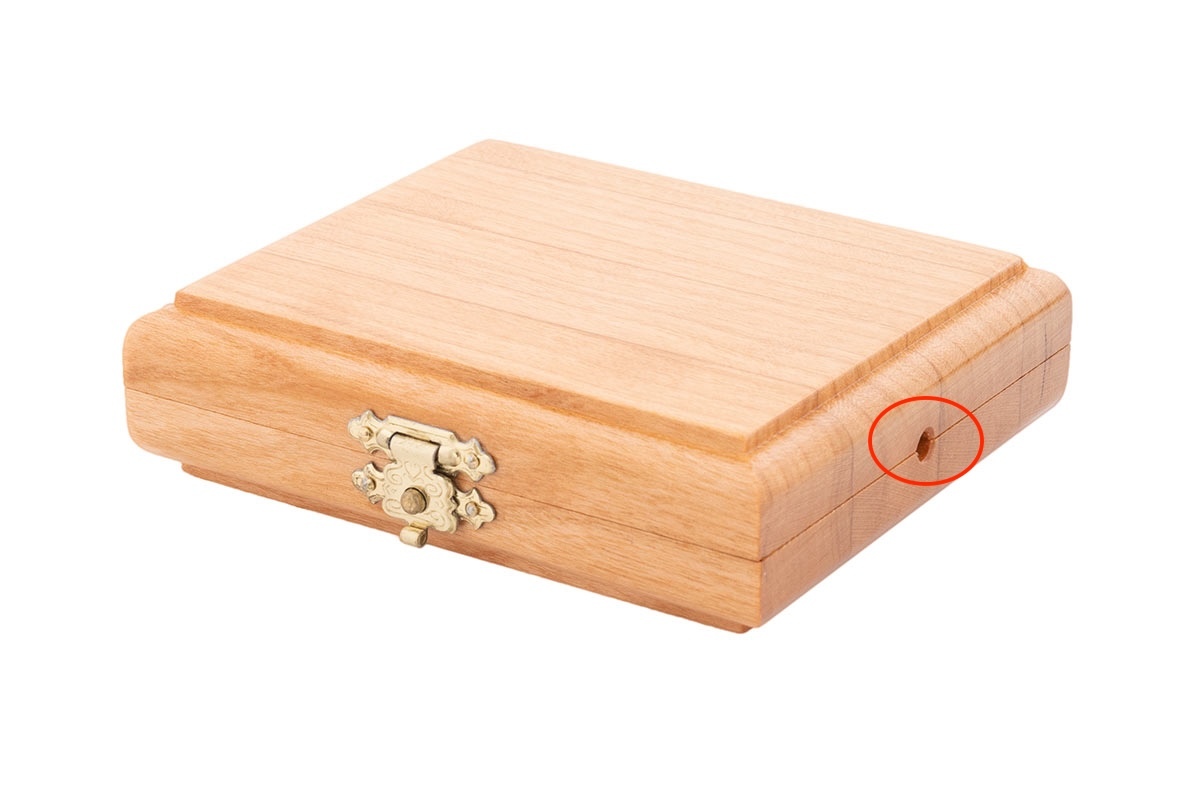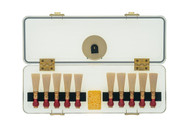The Do’s And Don’ts Of Bassoon Reed Care
Posted by Clair Cangialosi, DMA on Nov 3rd 2025
As many bassoonists know, a good reed can make all the difference when it comes to ease of playing. They can be expensive to buy and time consuming to make, so many bassoonists may wonder how they can get the most out of their reeds. We hem and haw over the details of cane selection, wire placement, and scraping technique, but what many don’t consider is how they are storing their reeds in between playing sessions.
The two main concerns with reed storage are the humidity level and air circulation. It may be helpful to consider this in relation to the children’s story, Goldilocks and the Three Bears (see figure 1). Just as Goldilocks experienced the various items in the home of the Three Bears to be too big, too small, or just right, reeds can be stored in environments which are too humid (with not enough air circulation), too dry (too much air circulation), or just right.

This post will outline the do’s and don’ts of reed storage to help keep your reeds playing beautifully. Read on for the details, or jump to each section below:
- Too Humid: Mold Causes and Prevention
- Too Dry: Bad Response and Resonance
- Just Right: Ideal Relative Humidity
- Conclusion
- Works Cited
Too Humid: Mold Causes and Prevention

Picture this: You’ve just made a batch of reeds, and are all set for your upcoming semester/concert cycle/tour. Your reed making routine is a well-oiled machine- you have reeds in various stages of the finishing process tucked neatly into your reed cases.
Then, disaster strikes- (as in figure 2, left) you open your case one day to find that your reeds are covered in mold! Yuck!
Reed cane, also known as arundo donax, is a type of tall perennial grass. As many readers are aware, cane must be soaked during each step of the reedmaking process as well as before playing. Soaking makes the wood pliable and helps it vibrate. Being a natural substance, this need for soaking also makes cane susceptible to growing mold if not allowed to dry properly in between uses.
As bassoonist Jessi Vandagriff notes, mold can also be caused by the following factors: (1)
- Storing your reed case inside your bassoon case, where there is less ventilation.
- Playing right after eating- food particles in your saliva are food for the mold!
- A dirty reed case- previous mold infestations can linger
- A gunky bocal- buildup inside the bocal can also lead to mold growth
What to do if a reed gets mold on it?
The short answer is to throw it away. As a last resort, submerge in a 1:1 solution of hydrogen peroxide and water for a couple of minutes to kill the mold and then air dry completely before playing.
The more long term solution is to invest in a case that allows for sufficient airflow. Look for small holes on the side of the reed case as shown in figure 3. Never use the plastic shipping tubes as a regular reed case (at the very least, take the reed out and poke a few holes in the plastic).

Too Dry: Bad Response and Resonance
On the opposite end of the spectrum is a reed storage environment which is too dry. When cane dries, the fibers of the wood contract, causing the reed to shrink. This is most noticeable in wires that have become loose and slipped out of position. Excessive dryness also decreases the ability of the cane to vibrate readily, resulting in reeds that feel stuffy or unresponsive.
If you live somewhere that experiences cold winters, this can be especially problematic. Here in Virginia, the humidity can fluctuate between a swampy 77% in the summer to 67% in January (having the heat on in your house during the winter will also play a role). It may be helpful to check the climate and weather averages in your area to better understand how your reeds will be affected by the changing seasons. (2)
In extremely dry climates, it may be helpful to keep your reed case inside a ziplock bag to prevent excessive drying out. The author also opts to soak reeds in warm water, and allow more time for soaking during the winter months.
In the video below, bassoonist Andrew Burn describes the differences in his reed storage routine depending on the weather. He also advocates for placing a small sponge with a few drops of mouthwash inside the reed case. The liquid helps keep the reeds sufficiently hydrated, while also preventing the growth of mold or bacteria.
Just Right: Ideal Relative Humidity
As we have already discussed, the longevity and performance of a reed is heavily influenced by environmental factors. Is there a “just right” combination of humidity level and air flow that will both prevent mold, and allow reeds to play at their best?
First, a bit of science:
Relative Humidity, expressed as a percentage, is a measure of the amount of moisture in the air compared to the maximum amount of water vapor that could exist in the air at a given temperature. Warm air can hold more water vapor than cold air. (3) Figure 4 shows the relationship between temerpature and relative humidity.
Some bassoonists believe that keeping their reeds at a fairly constant relative humidity level helps to increase the reed’s lifespan and prevent both the “too humid” and “too dry” scenarios described above. Some players may find that an ideal relative humidity is between 68-72%, but the exact number will depend on the climate where you live and the conditions under which you perform.

Barry Stees recommends storing your reed case along with a piece of orange peel in a ziplock bag with a small hole cut in it. The orange peel adds moisture, while the hole prevents mold growth. (4) Some players also use cigar humidifier packs (placed inside a plastic bag along with the reed case), which absorb and release moisture accordingly to keep the humidity at a constant level.
Another option is to use a reed case equipped with humidity control such as the Reed’s N Stuff Hygro Case or the Musecho Leafy Case (see figure 4). These both contain a small sponge which releases moisture inside of the case as well as a dial which measures the humidity inside of the case. It is important to note that it is necessary to periodically open the case to allow air to circulate.
Conclusion
Proper storage is an important component for ensuring that you get the most out of your reeds.
Below is a summary of the do’s and don’ts of bassoon reed care.

Questions? Contact us through our website. We’re here to help you craft the perfect sound!
Works Cited:
- Vandagriff, Jessie. “Help For Moldy Reeds.” TeachBassoon.com. Accessed September 9th 2025. https://www.teachbassoon.com/help-for-moldy-reeds/
- “Climate and Weather Averages in Northern Virginia, USA.” Timeanddate. Accessed September 9th 2025.https://www.timeanddate.com/weather/@12216875/climate
- “Discussion on Humidity.” The National Weather Service. Accessed September 11th 2025. https://www.weather.gov/lmk/humidity
- Stees, Barry. “Winterizing Your Bassoon Reeds.” Barry Blogs. January 7th, 2013. http://steesbassoon.blogspot.com/2013/01/winterizing-your-bassoon-and-reeds.html#:~:text=I%20try%20to%20keep%20the,keeps%20mold%20from%20building%20up.

